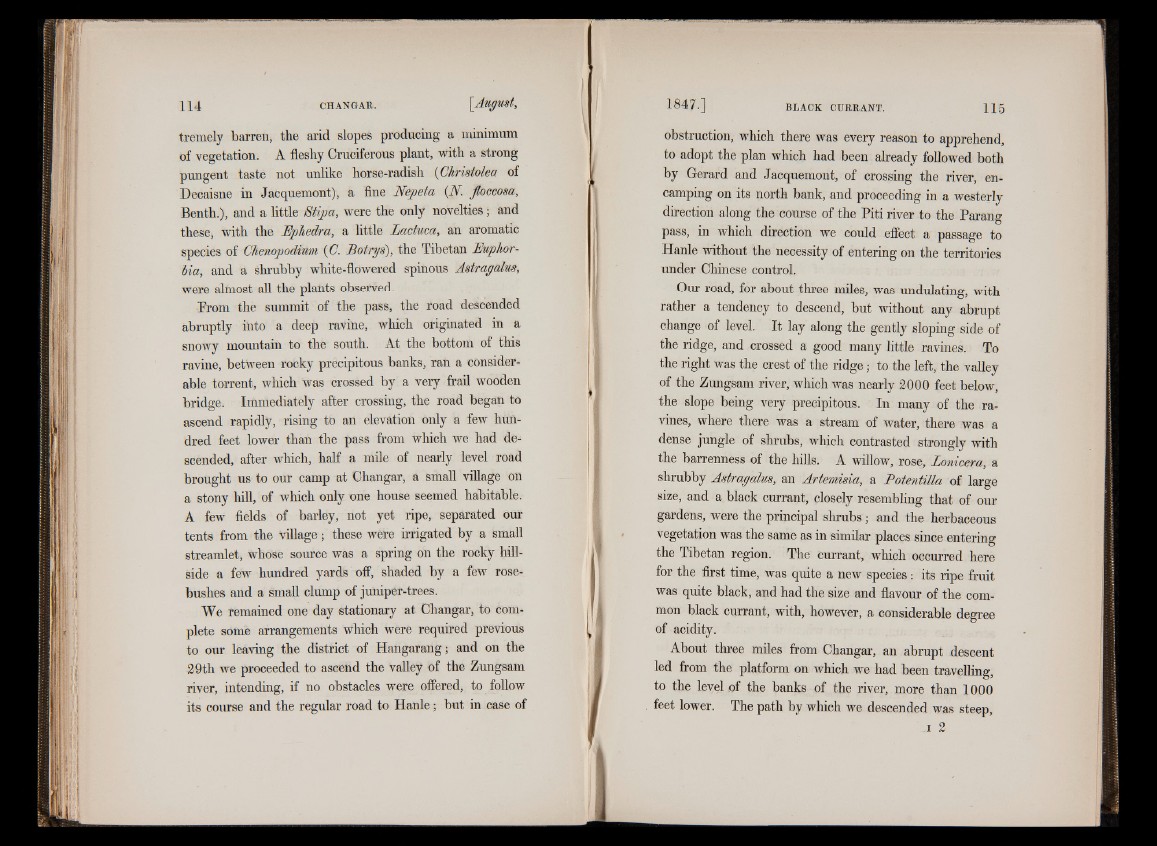
tremely barren, the arid slopes producing a minimum
of vegetation. A fleshy Cruciferous plant, with a strong
pungent taste not unlike horse-radish (Ghristolea of
Decaisne in Jacquemont), a fine Nepeta {N. floccosa,
Benth.), and a little Stipa, were the only novelties | and
these, with the Ephedra, a little Lactuca, an aromatic
species of Chenopodinm (C. Botrys), the Tibetan Euphorbia,
and a shrubby white-flowered spinous Astragalus,
were almost all the plants observed.
Prom the summit of the pass, the road descended
abruptly into a deep ravine, which originated in a
snowy mountain to the south. At the bottom of this
ravine, between rocky precipitous banks, ran a considerable
torrent, which was crossed by a very frail wooden
bridge. Immediately after crossing, the road began to
ascend rapidly, rising to an elevation only a few hundred
feet lower than the pass from which we had descended,
after which, half a mile of nearly level road
brought us to our camp at Changar, a small village on
a stony hill, of which only one house seemed habitable.
A few fields of barley, not yet ripe, separated our
tents from the village; these were irrigated by a small
streamlet, whose source was a spring on the rocky hillside
a few hundred yards off, shaded by a few rosebushes
and a small clump of juniper-trees.
We remained one day stationary at Changar, to Complete
some arrangements which were required previous
to our leaving the district of Hangarang; and on the
29th we proceeded to ascend the valley of the Zungsam
river, intending, if no obstacles were offered, to follow
its course and the regular road to Hanle; but in case of
obstruction, which there was every reason to apprehend,
to adopt the plan which had been already followed both
by Gerard and Jacquemont, of crossing the river, encamping
on its north bank, and proceeding in a westerly
direction along the course of the Piti river to the Parang
pass, in which direction we could effect a passage to
Hanle without the necessity of entering on the territories
under Chinese control.
Our road, for about three miles, was undulating, with
rather a tendency to descend, but without any abrupt
change of level. It lay along the gently sloping side of
the ridge, and crossed a good many little ravines. To
the right was the crest of the ridge; to the left, the valley
of the Zungsam river, which was nearly 2000 feet below,
the slope being very precipitous. In many of the ravines,
where there was a stream of water, there was a
dense jungle of shrubs, which contrasted strongly with
the barrenness of the hills. A willow, rose, Lonicera, a
shrubby Astragalus, an Artemisia, a Potentilla of large
size, and a black currant, closely resembling that of our
gardens, were the principal shrubs; and the herbaceous
vegetation was the same as in similar places since entering
the Tibetan region. The currant, which occurred here
for the first time, was quite a new species : its ripe fruit
was quite black, and had the size and flavour of the common
black currant, with, however, a considerable degree
of acidity.
About three miles from Changar, an abrupt descent
led from the platform on which we had been travelling,
to the level of the banks of the river, more than 1000
feet lower. The path by which we descended was steep,
i 2